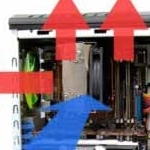4 PC Cooling techniques that demonstrate why heat sinks & fans are still the best cooling options.–PC Pitstop.
4 PC Cooling Techniques
By Damien for MakeTechEasier
Have you ever wondered why we haven’t evolved from the basic fan and heat sink for the cooling of most consumer-level computers? Aside from liquid cooling (which is still a niche market at best), there seems to be no other alternative available. There are, however, a few people who aren’t satisfied with simply thinking outside the box when it comes to CPU/GPU cooling. They take that box, rip it out, and put their own in its place. Despite their best efforts, there’s still a good reason why we’re sticking to heat sinks and fans.
1: Freon (R134A) Cooling
The first image that pops into most people’s heads when listening to the word “cool” is their fridge. It’s logical, right? The appliance is loaded with a gas known as freon that circulates through a compressor in a way that cools down any given volume in a relatively short time.
It turns out that people have been building freon-cooled PCs for a while now. Check out this video from 2011:
Here’s the flaw: As the air around your CPU gets cooler, the natural vapor in that air begins to condense. Condensation and electronics are sworn enemies. If you get enough of that condensation to drip onto an active part of your circuit board, you can wave goodbye to your computer. To solve this, you either need to coat your entire motherboard with rubber that leads into a drip pan, or leave it inside a vacuum with absolutely no humidity. Freon cooling is a nice gimmicky idea, but it’s not a viable long-term cooling solution for most people.



